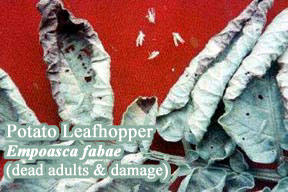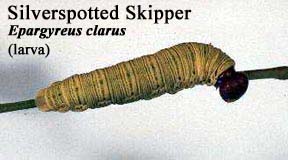Wisteria (Wisteria)
Plant Health Problems
This host is relatively problem-free and has no serious disease
problems in Connecticut.
Insect Problems:
Mealy flata, Ormenis septentrionalis.
These insects are often found on wisteria. This is one of the
largest of the lantern flies, which are sucking bugs. The eggs
are laid in slits in the bark of stems and covered with masses of
a white wax secretion. This insect is found on a great variety of
herbaceous plants and shrubs. There is one annual generation and
the adults are present in August and September. Although control
measures are usually not necessary, the insect may be controlled
by spraying with insecticidal soap or malathion, which are among
the compounds registered for use against this pest in
Connecticut. Imidacloprid may also be applied as a systemic to be
taken up by the roots. Consult the label for dosage rates and
safety precautions.
 Potato leafhopper, Empoasca fabae.
Potato leafhopper, Empoasca fabae.
Leafhoppers will feed on the new growth of wisteria. This insect
is a serious pest in some years in Connecticut. It does not
overwinter here, and the severity of infestation depends on the
size of the migrating population and the weather. The adult is
about 1/8" long and yellowish green. Nymphs are similar in
color but have no wings. Both adults and nymphs are difficult to
see because they move rapidly. Adults and nymphs may infest and
cause injury by sucking sap from the bottom side of leaves. This
causes the young leaves to curl or gives them a white peppered
appearance. Continued feeding results in a yellowing or browning
of the leaves, called "hopperburn." Among the compounds
registered for control of this pest in Connecticut are pyrethrum,
carbaryl and insecticidal soap. Repeated use of insecticides
other than soap, may lead to outbreaks of aphids. Imidacloprid,
applied as a soil drench, will provide season-long systemic
control.
 Silverspotted skipper,
Epargyreus clarus.
Silverspotted skipper,
Epargyreus clarus.
The caterpillars feed upon wisteria. This is one of the largest
of the skipper butterflies, and the larvae feed on the leaves of
locust, the rose acacia and wisteria. Each caterpillar fastens
together several leaflets with silk threads, making a case in
which it lives and feeds. The caterpillar is leaf-green with a
brown head. The butterfly is brown with yellow and white
quadrangular spots on the forewings. Both front and rear wings
are sharp-pointed. Spraying carbaryl, malathion, spinosad or Bacillus
thuringiensis var. kurstaki, which are among the
compounds registered for use against this pest in Connecticut,
when larvae are present should provide control. Consult the
labels for dosage rates and safety precautions.

